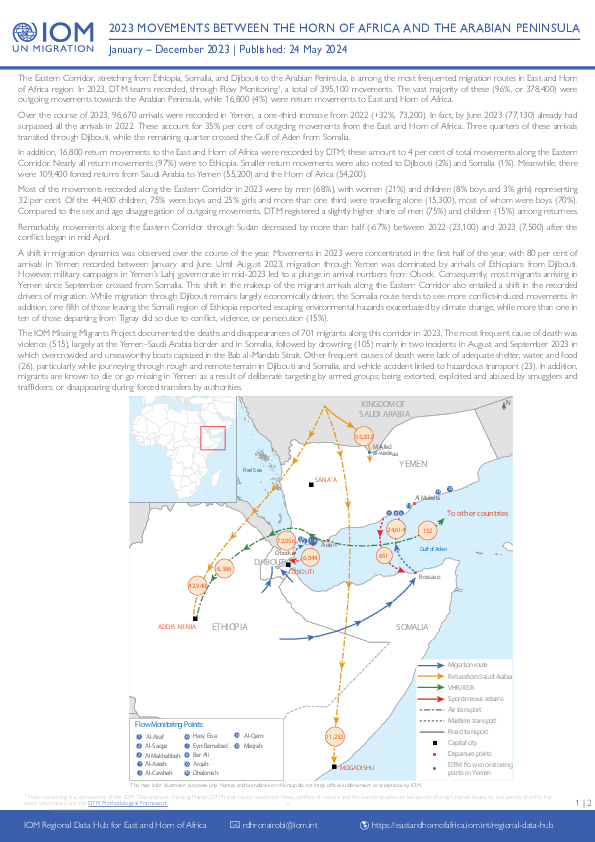-
Countries
-
Data and Analysis
-
Special Focus
-
Crisis Responses
Flow Monitoring
• Exit movements from Ethiopia (20,260) were the highest tracked since 2018, an 11% increase from the previous highest figure in March 2024.
• In April, two separate shipwrecks occurred in which 87 people making return journeys to the Horn of Africa perished near Obock, including children. The boats departed from Yemen and capsized off the coast of Djibouti due to overloading of the vessels.
• In the Ma’rib governorate of Yemen, flooding occurred in areas hosting stranded migrants, which exerted pressure on their dilapidated
shelters and triggered pushed many on the move once again.
• Due to the campaign against irregular migration in the Bab-al Mandab Strait, there have been almost no migrant arrivals from Djibouti in the
Lahj Governorate since October 2023.
• As it remains difficult for migrants to obtain employment on farms in Ma’rib Al Wadi, many chose to return to their home countries via the
Red Sea using smugglers for the risky journey, while others were deported by boat from Yemen to the Horn of Africa.
• Over 13,000 people were forcibly returned from Saudi Arabia to Ethiopia in April, the largest number since April 2023.
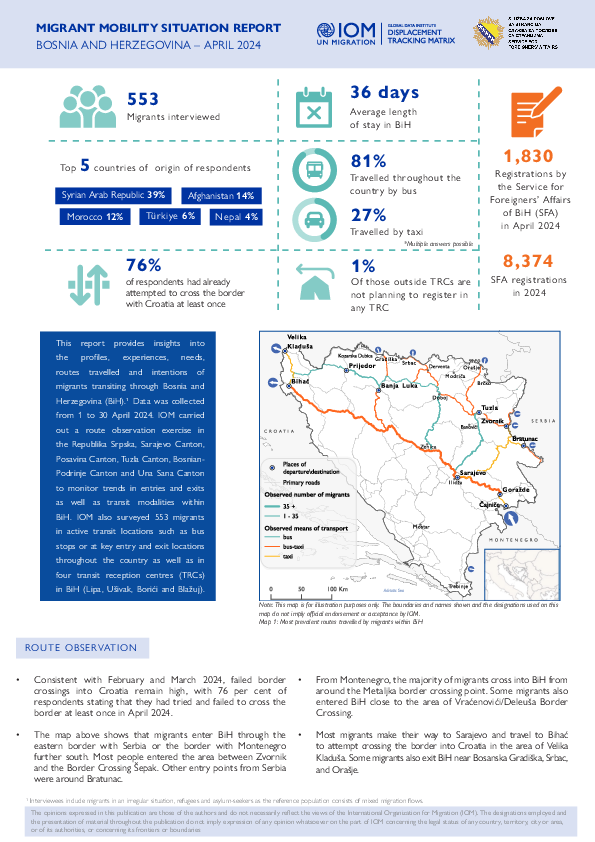
Contact
DTM Europe, DTMMediterranean@iom.int
Language
English
Location
Bosnia & Herzegovina
Period Covered
Apr 01 2024
Apr 30 2024
Activity
- Flow Monitoring
This report provides insights into the profiles, experiences, needs, routes travelled and intentions of migrants transiting through Bosnia and Herzegovina (BiH). Data was collected from 1 to 30 April 2024. IOM carried out a route observation exercise in the Republika Srpska, Sarajevo Canton, Posavina Canton, Tuzla Canton, Bosnian-Podrinje Canton and Una Sana Canton to monitor trends in entries and exits as well as transit modalities within BiH. IOM also surveyed 553 migrants in active transit locations such as bus stops or at key entry and exit locations throughout the country as well as in four transit reception centres (TRCs) in BiH (Lipa, Ušivak, Borići and Blažuj).

Contact
DTM Mauritania, DTMMauritania@iom.int
Language
French
Location
Mauritania
Period Covered
Feb 11 2024
May 07 2024
Activity
- Survey
- Flow Monitoring Survey
- Flow Monitoring
La transhumance est une tradition par laquelle des éleveurs se déplacent à la recherche d’eau et de pâturages. En Mauritanie, pays désertique, elle constitue un moyen d’adaptation pour les transhumants afin de palier au déficit de ressources pastorales. De ce fait des mouvements de transhumance sont observés principalement de la Mauritanie vers le Mali. Cependant, des mouvements inverses sont également notés, motivés principalement par la recherche de cure salée en Mauritanie par les transhumants Maliens ou Sénégalais. Ainsi, le calendrier et les itinéraires de transhumances se font en concordance des pluies, ainsi que de la distribution de l’eau et des pâturages, qui varient d’une saison à l’autre. Compte tenu des conditions environnementales difficiles en Mauritanie et des répercussions sur les productions végétales et animales, y compris sur la sécurité alimentaire des populations, et dans le contexte actuel d’aléas climatiques, économiques et sécuritaires croissants, on constate que les systèmes de mobilité pastorale connaissent des évolutions importantes sous les effets combinés du changement climatique, de la pression démographique, de la baisse de la fertilité des sols et de l’insécurité.
Dans le cadre du projet « Soutenir les capacités locales et communautaires de prévention et de gestion des conflits et des catastrophes liées au changement climatique au Guidimaghaa » financé par le Peace Building Fund (PBF) et mis en œuvre par l’Organisation internationale pour les migrations (OIM), au niveau de la Wilaya du Guidimaghaa, plusieurs activités sont mises en place y compris des activités de collecte de données sur la migration et le changement climatique.
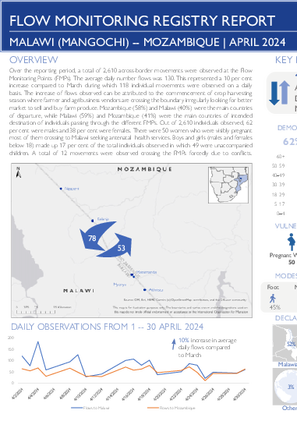
Contact
ROPretoriaRMDHub@iom.int
Language
English
Location
Malawi
Period Covered
Apr 01 2024
Apr 30 2024
Activity
- Flow Monitoring
This report is an overview of the data collected from 1 to 30 April 2024 at Mangochi FMP in Malawi along the border with Mozambique and Karonga FMP in Malawi along the border with the United Republic of Tanzania. The Flow Monitoring Registry (FMR) collects data at Flow Monitoring Points (FMPs) through direct observation and interviews with key informants, including staff working at transit stations, border patrol officers, local authorities, bus or taxi drivers and travellers themselves. The FMR gathers data on the number of travellers crossing FMPs, as well as the provenance, next destination, vulnerabilities and means of transport of travellers.
This report provides insights into the profiles, experiences, needs, routes travelled and intentions of migrants transiting through the Western Balkans.
IOM surveyed 1,033 migrants from 1 April to 30 April 2024 in Albania, Bosnia and Herzegovina, Montenegro, North Macedonia, Serbia and Kosovo*.
* References to Kosovo* shall be understood in the context of UN Security Council Resolution 1244 (1999).
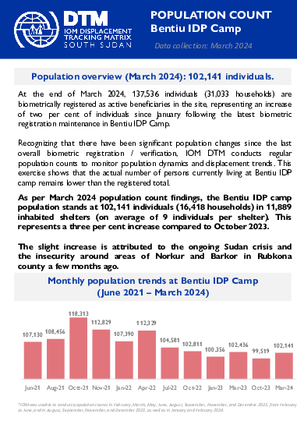
Contact
DTM South Sudan, SouthSudanDTM@iom.int
Language
English
Location
South Sudan
Period Covered
Mar 01 2024
Mar 31 2024
Activity
- Registration
- Flow Monitoring
- Mobility Tracking
- Site Assessment
As per March 2024 population count findings, the Bentiu IDP camp population stands at 102,141 individuals (16,418 households) in 11,889 inhabited shelters (on average of 9 individuals per shelter). This represents a three per cent increase compared to October 2023.
Over the course of 2023, 96,670 arrivals were recorded in Yemen, a one-third increase from 2022 (+32%, 73,200). In fact, by June 2023 (77,130) already had surpassed all the arrivals in 2022. These account for 35% per cent of outgoing movements from the East and Horn of Africa. Three quarters of these arrivals transited through Djibouti, while the remaining quarter crossed the Gulf of Aden from Somalia
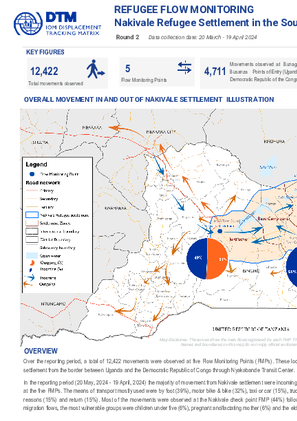
Contact
dtmuganda@iom.int
Language
English
Location
Uganda
Period Covered
Mar 20 2024
Apr 19 2024
Activity
- Flow Monitoring
Over the reporting period, a total of 12,422 movements were observed at five Flow Monitoring Points (FMPs). These locations were chosen strategically as major transit points for monitoring movements in and out of Nakivale settlement from the border between Uganda and the Democratic Republic of Congo through Nyakabande Transit Center.
In the reporting period (20 May, 2024 - 19 April, 2024) the majority of movement from Nakivale settlement were incoming flows (52%) against outgoing flows (48%). Forty-four per cent of the observed movements were refugees at the five FMPs. The means of transport mostly used were by foot (39%), motor bike & bike (32%), taxi or car (15%), truck (8%), bus (3%) and others (2%). The majority of the flows were due to economic reasons (26%), family reasons (15%) and return (15%). Most of the movements were observed at the Nakivale check point FMP (44%) followed by Busanza (19%), Bunagana (19%), Rugaaga (11%) and Nyakabande transit centre (7%). Among migration flows, the most vulnerable groups were children under five (6%), pregnant and/lactating mother (6%) and the elderly (<1%).
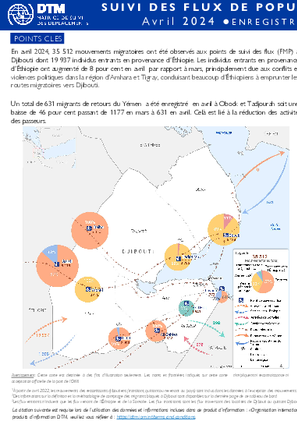
Contact
DTM Djibouti, DTMDjibouti@iom.int
Language
English
Location
Djibouti
Period Covered
Apr 01 2024
Apr 01 2024
Activity
- Flow Monitoring
En avril 2024, 35 512 mouvements migratoires ont été observés aux points de suivi des flux (FMP) à Djibouti dont 19 937 individus entrants en provenance d’Éthiopie. Les individus entrants en provenance d’Éthiopie ont augmenté de 8 pour cent en avril par rapport à mars, principalement due aux conflits et violences politiques dans la région d’Amhara et Tigray, conduisant beaucoup d’Éthiopiens à emprunter les routes migratoires vers Djibouti.
Un total de 631 migrants de retours du Yémen a été enregistré en avril à Obock et Tadjourah soit une baisse de 46 pour cent passant de 1177 en mars à 631 en avril. Celà est lié à la réduction des activités des passeurs.
Pagination
- Previous page
- Page 9
- Next page


